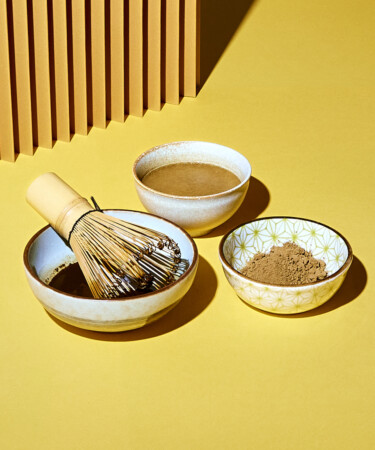It’s hard to overstate matcha’s popularity. Over the past decade, this vibrant, antioxidant-packed Japanese green tea powder has found a permanent place in U.S. homes and on the menus at our favorite coffee shops.
“Matcha is traditionally prepared with just water,” says Tristan Niskanen, barista at tea shop Nippon Cha in Williamsburg, Brooklyn, “but now it’s everywhere, from lattes to lemonades.”
Matcha is unlikely to be dethroned anytime soon, but it does have a new peer on the tea powder scene: enter hojicha. From a recent stint on the Blue Bottle Coffee menu to independent cafes nationwide, we’re seeing hojicha — sometimes erroneously called “black matcha” — make the rounds in tea and latte form. Consider this your proper introduction.
What Is It?
Hojicha, like matcha, is a powdered Japanese green tea. However, it looks and tastes quite a bit different.
“Matcha is a Japanese green tea, like sencha, that’s been stone-ground,” says Niskanen. “Hojicha is a Japanese green tea that’s been charcoal roasted.” Unlike matcha, which exclusively comes in powdered form, hojicha can be used as both a powder and a loose-leaf tea.
The charcoal roasting method gives hojicha a darker color and a richer, sweeter flavor, Niskanen explains. “Hojicha has a more umami, smoky flavor. It’s a little sweeter than matcha.” This is not due to higher sugar content, but instead is a result of the cooking process.
“All teas naturally have tannins,” he says. If you’ve ever prepared matcha with boiling water and little else, you’ve probably noticed some astringency, thanks to said tannins. The charcoal roasting process that hojicha undergoes denatures some of these tannins, as well as some of the caffeine. For those who find unflavored matcha unappealing, sweeter and roastier hojicha could be a great option. It also makes an easier switch for coffee drinks, Niskanen says, thanks to that extra depth of flavor.
Is It Technically Matcha?
Thanks to matcha’s ubiquity, some may be tempted to call hojicha powder “hojicha matcha.” It’s sometimes been nicknamed “black matcha.”
“I can understand why people would refer to it this way,” Niskanen says, “but technically, it’s incorrect.”
Hoji, he says, refers to the type of tea. Cha is another word for tea. Matcha is a different type of tea, even though they’re both green tea. To say “hojicha matcha” is both redundant and contradictory, Niskanen adds, comparing it to saying “chai tea” or “naan bread.”
How to Use It
“When I’m using hojicha powder, I prefer to make a hot latte with whole milk,” Niskanen says. But if it’s blazing hot outside or you simply prefer cold drinks, you do you. It’s not that an iced hojicha latte is bad, he clarifies, but you’ll get more depth of flavor by drinking it hot. “Oat milk is good, too, if you’re avoiding dairy,” he says. Unless you’re craving something very sweet, he says, try it without any added sweetener. “It’s already pretty sweet, and those rich smoky notes will be more present without added sugar.”
If you buy it to prepare lattes at home, first of all make sure that you’re buying the powder and not the loose-leaf tea. Then, use it the same way (and in the same quantities) that you’d use matcha powder, both for at-home barista work and otherwise.
“It can be great for baking, too,” Niskanen adds. “We’ve made some great hojicha brownies at the shop, and occasionally will serve a hojicha tiramisu where we sub the espresso for hojicha powder. I bet it would be great in cookies, too.”
